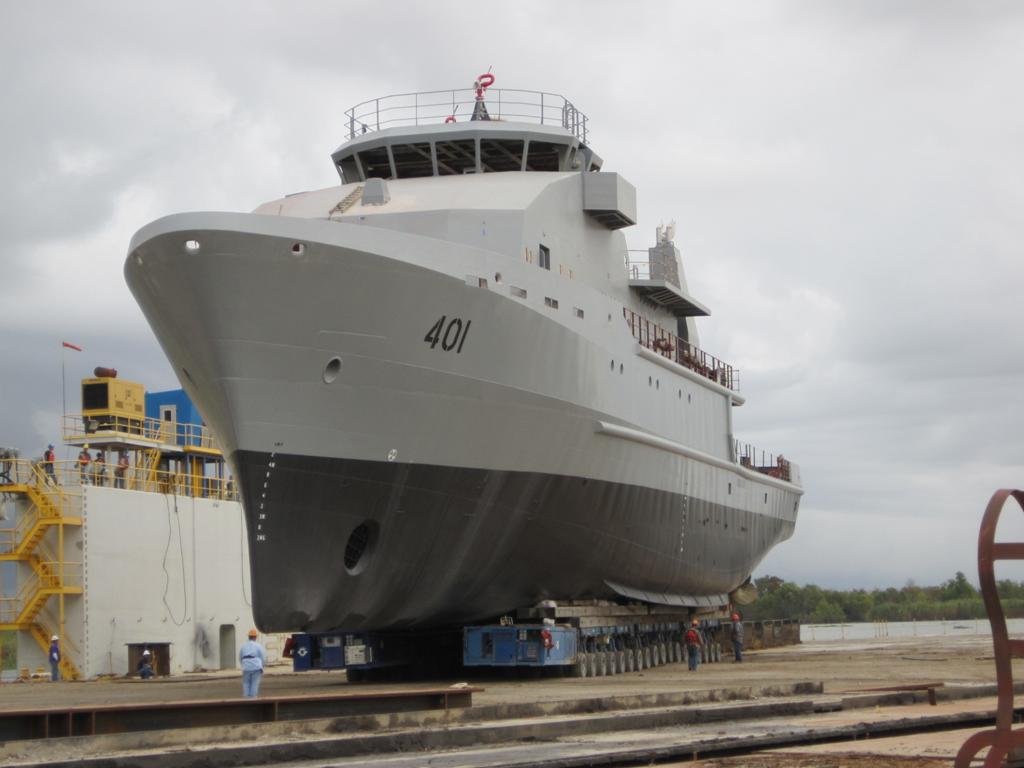
THE PENTAGON – As the Navy faces more complex threats to its manned ships from Russia and China, the service is moving quickly to field an unmanned “Ghost Fleet” — a new breed of armed unmanned surface combatants will add more sensors and weapons to the current fleet.
In Fiscal Year 2020, the Navy has budgeted $400 million for two of the proposed large unmanned surface vehicles in its research and development budget line. The Navy plans to continue buying two a year until FY 2024, for a total of about $2.7 billion.
“These are 200- to 300-foot [vessels], 2,000 tons. I’m not sure what the final hull form will be, that’s what we are using today in terms of what the Ghost Fleet buy will be,” Rear Adm. Randy Crites, deputy assistant secretary of the Navy for budget, said on Tuesday during a press budget briefing.

Unlike the small unmanned craft the Navy has experimented with in the past, the 10 large USVs the Navy wants to buy are the size of a small warship. The corvette-sized USVs are being developed to field different types of sensors and, eventually, vertical launch system (VLS) cells for a variety of guided missiles. However, it’s unclear how the unmanned systems will fit into the larger Navy force structure, how they will be measured as part of the battle force, how they would function with other platforms and what requirements for the Navy the systems would fulfill.
Based on Tuesday’s budget submission, it’s also unclear what the hull form for the large USV would be, but the Navy has used images of commercial offshore support vessels used in the oil and gas industry in unclassified presentations. The Navy is also developing a medium USV that would be 12 to 50 meters in length, or somewhere between the size of the service’s 11-meter rigid hull inflatable boats (RHIBs) and the Navy’s Cyclone-class patrol craft (PCs).
On Wednesday, Chief of Naval Operations Adm. John Richardson told reporters the Navy decided to accelerated the large USV’s development and fielding to the operational fleet after experimentation with smaller unmanned surface ships like the DARPA-developed Sea Hunter. He compared the effort to how the Navy experimented with carrier-based unmanned aerial vehicles for a while before quickly moving out on the MQ-25A Stingray that will begin operating off carrier decks in 2024.
“We’ve done some work in working with unmanned surface vessels and have made some progress there, and I would liken it to that. This is the surface vessel version of how we picked up on MQ-25 and are moving very aggressively to get something on deck in unmanned air,” Richardson said.
In terms of developing a large USV, the buy “seems like the next natural step. I want to move this past the [research and development] phase, if you will, and get it out into the operational phase as quick as we can.”

The move is part of the larger Pentagon push to align with the new National Defense Strategy that refocuses the Department of Defense to prepare for conflict with a near-peer adversary like Russia or China. Particularly, a potential conflict against China in the Western Pacific has driven decisions in how all the services pursue new weapon systems. For the Navy, a major consideration is the more than 1,000 nautical mile range of the People’s Liberation Army’s DF-21D and DF-26 family of anti-ship ballistic missiles.
“We have to guard against things like the DF-21, DF-26 and the whole plethora of Chinese missiles that can reach out and strike a surface fleet or territory out as far as Guam,” Alan Shaffer, deputy under secretary of defense for acquisition and sustainment, said on Wednesday at the McAleese defense conference in Washington, D.C.
Part of that includes developing “attritable” capabilities that include systems like the large USV that can keep manned platforms further away from threats.
“The overall benefits are that you can certainly reduce cost of the platform because you don’t have to support and protect people. You can also change the risk equation because you don’t have human life involved. By virtue of that you can potentially build more of them,” Richardson said on Wednesday.
Pentagon director of force structure, resources and assessments (J8) Army Lt. Gen. Anthony Ierardi told reporters on Tuesday during an FY 2020 budget briefing that the large USV was part of the Navy’s commitment to a larger push for unmanned systems throughout the DoD.
“There are requirements for the department to operate in a more autonomous manner. The Navy will begin to fulfill those requirements as we look at different ways of operating. This is about looking at the future differently than we’ve looked at the past,” he said.
“That doesn’t mean what we have today is less important or less critical in the next decade, two decades, even three decades; but it is an acknowledgement that we need to start to consider other ways of operating to enhance our lethality as our adversaries adapt and change their way of operating.”





